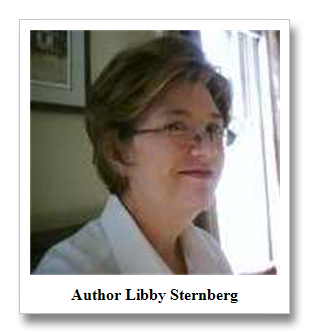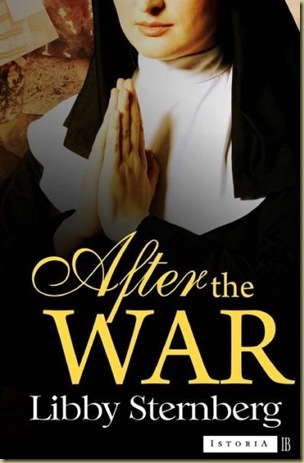
It’s always a pleasure to welcome author Libby Sternberg back to Thoughts. Today she joins us to talk about her novel, AFTER THE WAR (now available in print and for Kindle) and research she did for the book.
In addition, Libby has a surprise to share with readers during her post about this intriguing book.
Here’s a brief synopsis of AFTER THE WAR:
A decade after the war, its devastation still haunts them...
In the summer of 1955, a young nun awakens in Johns Hopkins Hospital after suffering an overdose, unable to remember the events that brought her there. As she recovers, she becomes the center of quiet struggles among those who surround her: her brother, a former GI still stung by betrayal during his years of service; her sister-in-law, a beautiful woman seeking love at any price; her confessor, a Jesuit priest who lost everything during the bombing of London; her nurse, a war widow whose sunny optimism leads to repeated disappointment; and her doctor, a psychiatrist beset by survival guilt and doubts about his profession's ability to heal.
Suffering from unseen war wounds ten years after the fighting ended, they each find their way to a very personal peace.
Here’s what Christy English, author of THE QUEEN’S PAWN, had to say about AFTER THE WAR - "...a touching novel of faith and family...an evocative story of love lost, and found, told with beautiful language and emotional clarity. A novel to savor."
Libby joins us to talk about ‘Researching the life of nuns in the 1940s and ’50s.’
Although my novel AFTER THE WAR follows several characters who, ten years after the end of World War II, are still dealing with the aftereffects of worldwide conflict, a key player around whom most of the action revolves is a young nun, Sister Francis Marie (born Margaret Wojehedski). Sister Francis Marie finds herself in the mental ward of a hospital, unable to remember the overdose that landed her there.
Writing the story of Sister Francis Marie led me to do quite a bit of research on orders of nuns, their various rules, and how their sisters led their lives. I myself had been taught by nuns from the Order of St. Francis in both elementary and high school years. I lived through the days when sisters wore heavy, voluminous habits and had little interaction—even as teaching sisters—with the outside world. Beyond this, however, I didn’t know anything about how they lived. The convent we passed every morning on our way into school was a house of mysteries.
Books provided my first resource for material. I read several memoirs of nuns who’d left their convents. And, of course, I read the well-known Nun’s Story and watched numerous times the wonderful movie of the same title starring Audrey Hepburn.
Each of these resources helped me construct the fictional order of nuns in my novel. From one memoir I learned of an order of nuns that was so strict about family contact that nuns had to choose between a visit to a deathbed or a visit for the funeral of a loved one. From another memoir, I learned of the practice of some sisters in one particular order eating more of the foods they disliked than the ones they liked.
But some of my best research was done in an interview with a nun who’d taught in my elementary school, Sister Ann Marie Slavin.
 I’d never had her as a teacher—my own sister had—but we found each other when she read one of my first books. Then, we friended each other on Facebook. I told her I was writing a novel featuring a nun and asked if I could chat with her. What a wonderful conversation that was!
I’d never had her as a teacher—my own sister had—but we found each other when she read one of my first books. Then, we friended each other on Facebook. I told her I was writing a novel featuring a nun and asked if I could chat with her. What a wonderful conversation that was!Sister Ann Marie Slavin entered the convent in 1959, four years after my fictional nun faced her very personal crisis. But the convent of 1959 was very similar to the one my character found herself in as she recalled her postulancy and novitiate. Sister Ann Marie filled in gaps for me and gave me extra telling details—such as how hot the habits of those days really were, how she personally struggled with keeping the linen pieces neat and flat, and how happy she was when the Second Vatican Council ushered in a new era of looser habits during the late 1960s and early 1970s. She also shared with me the fact that in her order, at least, they were not allowed to read novels—fiction of any kind!—for a long time. But she had a very kind mother superior who saw fit to break that rule with books such as Shoes of the Fisherman, a tale of a fictional pope.
By the time I spoke with Sister Ann Marie, my writing journey with AFTER THE WAR was nearly a decade old. I’d started the book years ago, focusing almost solely on my made-up Sister’s life and that of her sister-in-law, a Mary-Magdalene-like character who is searching for love more than faith. The story had never seemed quite right, however, so I kept putting it aside and coming back to it. Finally, I realized that I couldn’t tell Sister’s story without telling the stories of those who try to help her, including her doctor, nurse, and other members of her family.
This changed the outlook of the book somewhat, shifting it from an Everyman approach to faith and love to one that included reconciliation. Each character has been affected by the war. And each must walk their own healing journey toward forgiveness and acceptance. Discovering this theme was a “eureka” moment for me. Of course, I thought, of course this is the thread connecting each story.
I’m a baby boomer, so my parents’ generation came of age during the war. Even though my generation was born after it was over, we lived in its shadow—or, perhaps more precisely, in its sunlight, great drenching sunshine after years and years of dreadful grimness. My youth always felt to me as a collective sigh of relief: it’s over, the war is over.
I hope you enjoy AFTER THE WAR. It’s free today, July 8, at the Kindle store as part of a promotion. If you take advantage of this free offer, please consider penning a review or letting me know what you thought of the story!
Libby, thanks so much for joining us again and for sharing how this story came about. The life of nuns is quite intriguing and you’ve woven these characters together for a well-balanced story. Thanks also for sharing that AFTER THE WAR is FREE today!!
For those who haven’t meet Libby before, here’s a bit of background on her. She is the author of several historical novels and she was nominated for an Edgar for her first book, a teen mystery.
Her retelling of the Jane-Eyre story, SLOANE HALL, set in old Hollywood, has been praised as "An original story with complex character development...(Sternberg) knows how to tell a story and she does it well....a refreshing tale" by Carolyne Van Der Meer, Bronte Studies Journal.
For more on Libby and her writing, visit her website at http://www.libbysternberg.com/
Thanks everyone for visiting today. Do you enjoy books where you learn about other cultures and lifestyles, while being entertained with a delightful story?








Libby, thanks again for visiting today. Your research sounds intriguing and the book fascinating. Wishing you much success.
ReplyDeleteMason - Thanks for hosting Libby.
ReplyDeleteLibby - Thanks for sharing the research you did as you prepared this book. I always respect authors who take the trouble to really get to know their topic well and it's clear that you did that here. I wish you success.
Wow! I feel like I'm famous! And I so enjoyed this book!
ReplyDeleteThank you for hosting me! And thanks, Sister, for your help with this book. It was invaluable.
ReplyDeleteLibby